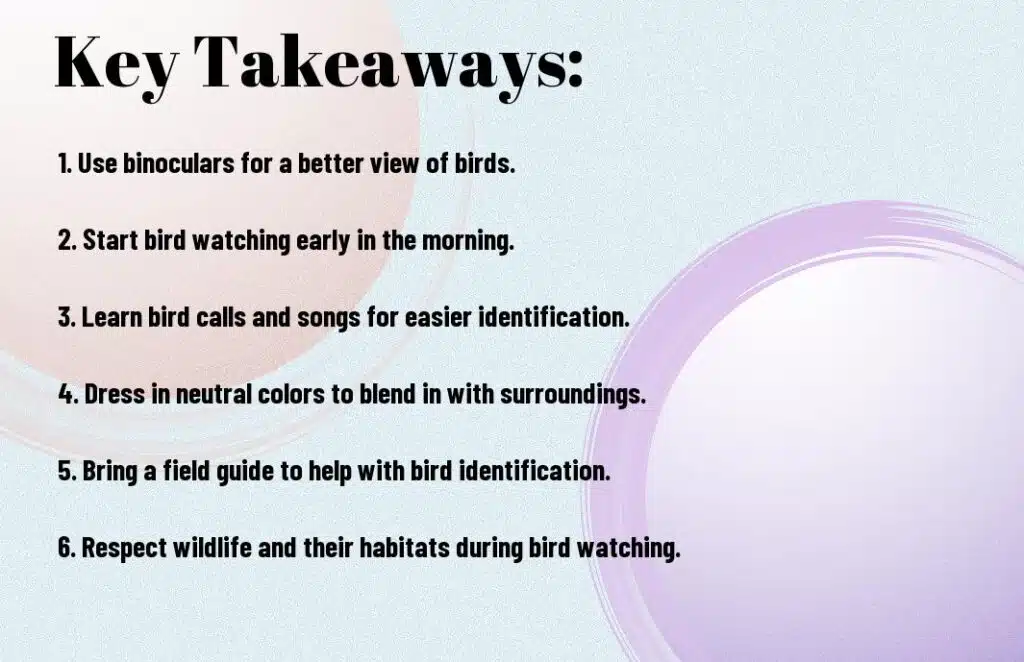You have decided to venture into the fascinating world of bird watching Birdwatching, a hobby loved by many nature enthusiasts worldwide. Whether you are exploring your backyard with the beginner bird watching tips will ensure a A successful outing in birdwatching often requires patience and the right optics for spotting and identifying birds from a distance.. From choosing the right equipment to understanding bird behaviors and habitats, this guide will help you in your birdwatching journey, serving as an essential birdwatching guide for beginners. spot and confidently identify birds. So grab your binoculars, pack a field guide, and immerse yourself in birdwatching’s beautyStart birding today!

Key Takeaways:
- Start with the imperative equipment: Having a good pair of binoculars, a field guide, and a notebook will enhance your bird watching experience and help you identify different species.
- Learn bird watching techniques: Practice using your binoculars properly, observing bird behavior, and recognizing bird calls to improve your bird watching skills over time.
- Choose the right location: Research the best bird watching spots in your area and visit during the early morning or late afternoon when birds are most active, following advice from seasoned birdwatchers. Be patient and quiet to spot more birds in their natural habitat. This patience is fundamental in beginner birdwatching.

Getting Started with Bird Watching
Choosing Your Bird Watching Gear
Some of the imperative gear for birdwatching includes a pair of binoculars with high magnification, a bird guide book, a notebook and pen for taking notes, and a birding journal to record your sightings. Consider investing in a spotting scope for long-range viewing and a camera to capture pictures of the birds you encounter.
Dressing for The Occasion
Bird watching often entails spending hours outdoors in various weather conditions, so it is important to dress appropriately. Wear comfortable, neutral-colored clothing that will help you blend in with your surroundings and not scare off any birds. Additionally, don’t forget to wear sturdy walking shoes or boots, ideally waterproof, to navigate different terrains during your birdwatching adventures. Bring along a hat, sunglasses, and sunscreen to protect yourself from the sun.
Getting Started with Bird Watching: Some imperative gear includes a pair of binoculars, a field guide book—like those recommended by Audubon or the Merlin Bird ID app, a notebook and pen for taking notes, and a birding journal to record your sightings and start your life list. Concerning dressing for the occasion, wear comfortable, neutral-colored clothing to blend in with your surroundings. Sturdy walking shoes or boots are a must, along with a hat, sunglasses, and sunscreen for protection from the sun.
Key Bird Watching Techniques
Understanding Bird Habitats and Behaviors
After choosing a location to go bird watching, take some time to observe the habitat and understand the behaviors of the birds that reside there. Different species of birds prefer different environments – some may live near water bodies, while others prefer dense forests or open fields, a fact that avid birdwatchers use to plan their outings. Understanding their habitats will increase your chances of spotting birds during your outing, enhancing your birdwatching experience.
The Art of Being Inconspicuous
To truly immerse yourself in the world of bird watching, it is crucial to master the art of being inconspicuous. Birds have keen senses and can easily be startled by sudden movements or loud noises. An important tip is to move slowly and quietly, blend into your surroundings by wearing neutral-colored clothing, and avoid sudden movements that may scare the birds away.
An important aspect of being inconspicuous is patience. While it may be tempting to move closer for a better look, it is crucial to maintain a safe distance to avoid disturbing the birds and disrupting their natural behaviors. Additionally, minimizing any noise, such as talking or rustling of leaves, will increase your chances of observing birds in their natural habitats.
Identifying Birds
Learning to Recognize Bird Calls and Songs
For beginner bird watchers, learning to recognize bird calls and songs Birdwatching can be a valuable skill in identifying birds during outings. Take the time to listen to recordings and practice identifying different calls. Soon you will be able to distinguish between the chirps and melodies of various bird species, including those in the
Visual Identification Tips
Any successful bird watcher knows that proper visual identification is key to a successful outing. Look for distinct features such as Observing color patterns is crucial for bird ID, a skill highly valued among birdwatchers. and Listening for unique calls is a fundamental aspect of birdwatching, aiding in identifying species even without visual confirmation. for effective bird ID. color patterns, size and shape, behavior, and habitat to help narrow down the possibilities. After observing these key characteristics, consult a field guide or birding app like Merlin Bird ID to confirm your identification.
- Color patterns
- Size and shape
- Behavior
- Habitat
Song identification Bird song can also be crucial in narrowing down bird species, as certain birds have distinctive songs that set them apart from others in the area. This is an essential aspect of bird identification. By familiarizing yourself with the unique calls of local birds, you can increase your chances of correctly identifying them during your bird watching adventures.

Enhancing Your Bird Watching Experience
Joining a Bird Watching Group
On your bird-watching journey, consider joining a bird-watching group to enhance your experience. Bird-watching groups provide opportunities to learn from experienced birders, share knowledge, and spot a wider range of bird species. Being part of a group can also make the outings more enjoyable and sociable.
Recording Your Observations
Bird watching is not just about spotting birds; it’s also about keeping track of your observations in a bird book, which can help in building a life list. Recording your observations can help you track bird species you have seen, their behaviors, and habitats. You can use a notebook, a bird watching app, or a dedicated bird watching journal to document your findings.
Plus, recording your observations can contribute to citizen science efforts and help researchers monitor bird populations and their trends. Your data can play a crucial role in conservation efforts and contribute to the understanding and protection of bird species.
Final Words
Upon reflecting on the step-by-step beginner bird watching tips provided, it is clear that with proper preparation and knowledge, anyone can have a successful outing in the world of birding. By following these tips, from choosing the right equipment to practicing patience and observation, beginners can enhance their bird watching experience and deepen their appreciation for the beauty of nature. Recall, bird watching is a journey that allows us to connect with the natural world and gain a greater understanding of the winged creatures that grace our skies. It’s an excellent way to start birding and appreciate the birds of North America. So, grab your binoculars, pack your field guide, and immerse yourself in the fascinating world of birds – a fulfilling adventure awaits!
FAQ
Q: What equipment do I need for bird watching as a beginner?
A: As a beginner in bird watching, you will need a pair of binoculars to get a closer look at the birds, a field guide to help you identify different species, a notebook to jot down observations, and appropriate clothing and footwear for outdoor excursions.
Q: Where is the best place to go bird watching for beginners?
A: The best place to start bird watching as a beginner is in your local parks, nature reserves, or even your backyard. These are ideal locations for birdwatching for beginners. These areas, often highlighted in bird guide books, tend to have a variety of bird species and are easily accessible for observing and learning about different birds.
Q: How can I attract more birds to my backyard for bird watching?
A: To attract more birds to your backyard for bird watching, you can set up bird feeders with different types of seeds, provide fresh water in a birdbath, plant native plants that provide food and shelter for birds, and create a welcoming environment free from predators.
As a bird enthusiast with a passion for sharing the wonders of our feathered friends. As a writer and nature lover, I'm thrilled to connect with fellow bird buffs and inspire others to take flight into the fascinating world of birds. Let's wing it together!


